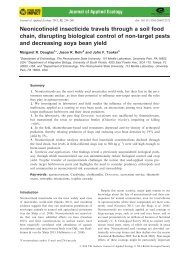Jones-et-al-2014
Jones-et-al-2014
Jones-et-al-2014
Create successful ePaper yourself
Turn your PDF publications into a flip-book with our unique Google optimized e-Paper software.
samples from 15 of the 18 fields sampled, at levels up to 10.7 µg/kg in the centre of fields,<br />
even though this chemic<strong>al</strong> had apparently only been used in two of these fields since 2010.<br />
4. DISCUSSION<br />
The results demonstrate that d<strong>et</strong>ectable levels of neonicotinoids are present in soil for a<br />
considerable time after use in UK conditions. In a number of fields, residues were d<strong>et</strong>ected<br />
of chemic<strong>al</strong>s that had not apparently been used in the previous three years. These residues<br />
are unlikely to have arisen from an<strong>al</strong>ytic<strong>al</strong> error as the procedure used, which employed LC-<br />
MS/MS d<strong>et</strong>ection, is highly specific. Furthermore the acquisition of data from two MS/MS<br />
channels for each chemic<strong>al</strong> <strong>al</strong>lowed for one of these channels to be used for confirmatory<br />
purposes. In <strong>al</strong>l cases, residues d<strong>et</strong>ected were present in chromatograms from both channels,<br />
and there was very good quantitative agreement b<strong>et</strong>ween channels, giving a very high level of<br />
confidence that these residue were actu<strong>al</strong>ly present. Such residues do not necessarily arise<br />
from applications made more than three years previously. Some may have resulted from<br />
subsequent applications made to surrounding fields e.g. from dust drift since it is clear that<br />
these chemic<strong>al</strong>s were in widespread use from 2010 to 2012. This may explain the d<strong>et</strong>ection<br />
of clothianidin in the only field which had not received clothianidin or thiam<strong>et</strong>hoxam in the<br />
last 3 years. It is unlikely to be the primary reason why thiam<strong>et</strong>hoxam was d<strong>et</strong>ected in 7<br />
fields to which it had not been applied for over 3 years, since in <strong>al</strong>l 7 fields, levels were<br />
higher in the centres than the edges. Dust drift would be expected to result in concentrations<br />
at field edges that were comparable or higher than those in field centres. It is extremely<br />
unlikely that the presence of imidacloprid residues in 13 fields which had not received<br />
applications of this chemic<strong>al</strong> in the previous 3 years could have arisen from contamination<br />
from surrounding fields since imidacloprid use in the UK has been declining in recent years;<br />
amounts used dropped by around 80% b<strong>et</strong>ween 2005 and 2010 11 and the application records<br />
from the fields included in this study suggest use has remained relatively low since 2010.<br />
This article is protected by copyright. All rights reserved




